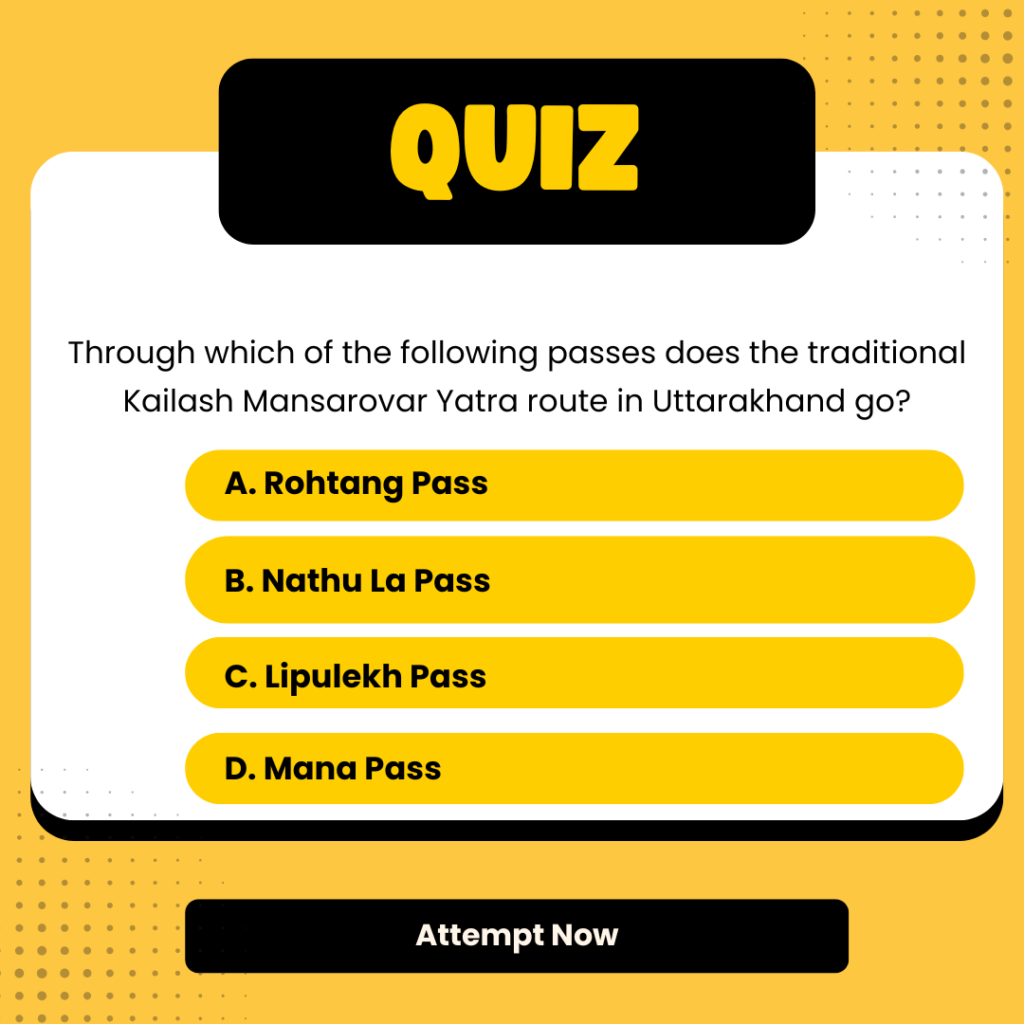The Kailash Mansarovar Yatra (KMY) is a significant annual pilgrimage symbolizing deep religious and cultural ties between India and China. It holds immense importance for Hindus, Buddhists, Jains, and followers of the Bon religion. Circumambulating Mount Kailash is believed to bring spiritual merit, and bathing in Lake Mansarovar is thought to cleanse one’s sins. The pilgrimage was suspended in 2020 due to the COVID-19 pandemic and border tensions. Its resumption after five years marks a positive development in religious tourism and bilateral cooperation.
Why in News?
- On April 26, 2025, the Ministry of External Affairs (MEA) announced the resumption of the Kailash Mansarovar Yatra.
- The pilgrimage will be conducted between June and August 2025.
- A total of 750 pilgrims will be allowed, divided into batches traveling via Lipulekh Pass (Uttarakhand) and Nathu La Pass (Sikkim).
What is Kailash Mansarovar Yatra?
The Kailash Mansarovar Yatra is an annual government-organized pilgrimage for Indian citizens to visit Mount Kailash and Lake Mansarovar in Tibet Autonomous Region, China. It has deep religious significance:
- Hindus consider Mount Kailash as the abode of Lord Shiva.
- Buddhists regard it as the dwelling of Buddha Demchok.
- Jains believe it is where their first Tirthankara attained liberation.
- Bon religion followers worship it as a sacred mountain.
The main objective of the yatra is to promote religious pilgrimage and cultural exchange between India and China.
Key Details or Features
There are two official routes for the pilgrimage:
- Lipulekh Pass (Uttarakhand): Traditional route operational since 1981.
- Nathu La Pass (Sikkim): Motorable route introduced in 2015.
Pilgrim details:
- Five batches of 50 pilgrims each will travel via Lipulekh Pass.
- Ten batches of 50 pilgrims each will travel via Nathu La Pass.
The registration process is fully computerized through https://kmy.gov.in, ensuring a fair, random, and gender-balanced selection. The yatra is coordinated by multiple agencies, including the MEA, Ministry of Home Affairs, Indo-Tibetan Border Police (ITBP), and the state governments of Uttarakhand, Sikkim, and Delhi, along with Kumaon Mandal Vikas Nigam (KMVN).
Impact/Significance
The resumption of the yatra carries several important implications:
- Religious and Cultural: Reinforces spiritual traditions and the faith of devotees.
- Diplomatic Relations: Symbolizes improving India-China ties through people-to-people interaction.
- Economic Benefits: Boosts tourism in Uttarakhand and Sikkim, generating local employment in hospitality, transport, and logistics sectors.
- Strategic Value: Enhances border infrastructure and connectivity, strengthening national security in sensitive regions.
Challenges or Concerns
Despite the positive developments, several challenges persist:
- Security: Continued tensions along the Line of Actual Control (LAC) pose risks.
- Logistics and Safety: Harsh terrain, high altitudes, and unpredictable weather endanger pilgrims’ health.
- Diplomatic Sensitivity: Fragile relations with China mean that adverse incidents could escalate tensions.
- Environmental Concerns: Increased pilgrim traffic may lead to ecological degradation in the fragile Himalayan ecosystem.
Way Forward/Solutions
A holistic approach is needed to ensure the smooth and safe conduct of the yatra:
- Enhance Safety Measures: Strengthen medical screening, emergency facilities, and rescue operations.
- Maintain Diplomatic Dialogue: Sustain engagement with China to avoid misunderstandings and promote cooperation.
- Sustainable Infrastructure Development: Improve roads, communication, and shelter facilities with minimal ecological damage.
- Ecological Protection: Enforce strict waste management and promote eco-friendly tourism practices.
- Pilgrim Training: Provide high-altitude acclimatization and environmental awareness programs to participants.





 Overall LFPR Show Upward Momentum as Une...
Overall LFPR Show Upward Momentum as Une...
 BofA Report: India Tops Global Charts in...
BofA Report: India Tops Global Charts in...
 Sculptor Ram Sutar, Designer of Statue o...
Sculptor Ram Sutar, Designer of Statue o...







